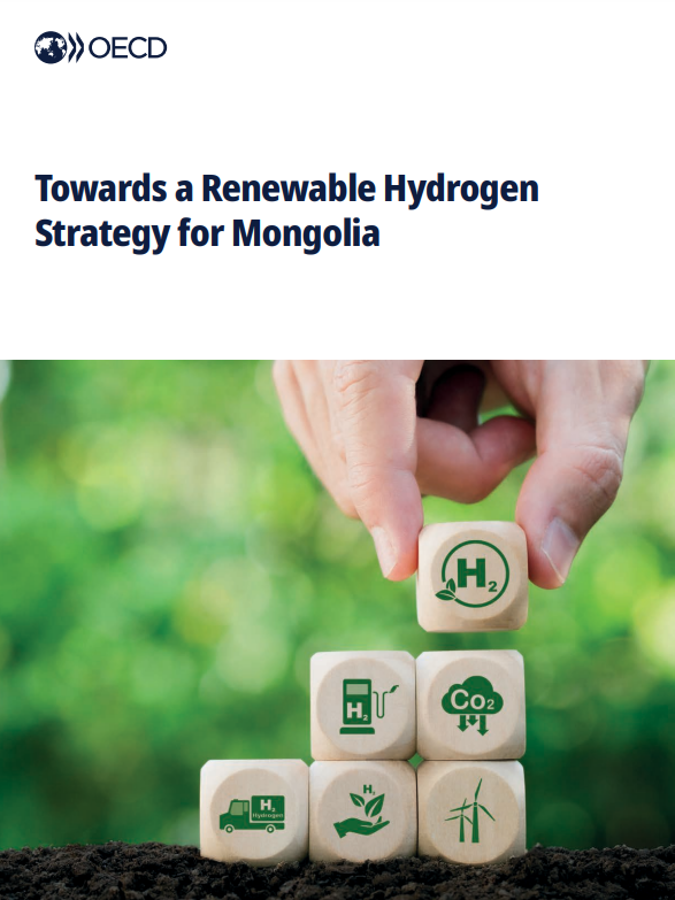
|
Towards a Renewable Hydrogen Strategy for Mongolia
Thanks to its very high levels of solar irradiation and wind-power generation capacity, Mongolia has attracted interest from the private sector as a potential location to develop renewable hydrogen pilot projects. At the same time, the government has included the development of hydrogen production as an element of the energy pillar of its New Recovery Policy.
2025.03
OECD/ENV
|
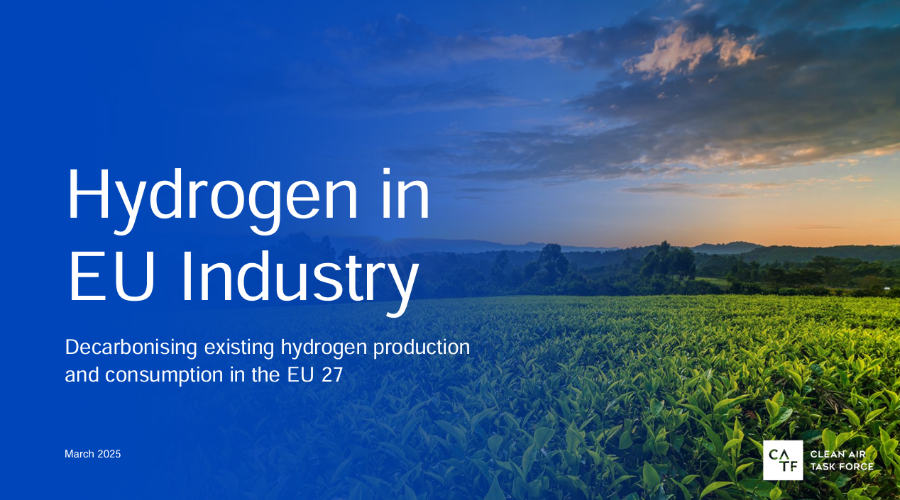
|
Hydrogen in EU Industry : Decarbonising existing hydrogen production
and consumption in the EU 27
This graphical report highlights the current role of hydrogen in industry in the EU 27 – namely in the refining and chemical industries – demonstrating a clear and necessary uptake for any clean hydrogen produced in Europe in the foreseeable future.
2025.03
CATF
|

|
2023 Year in Review: Climate-driven Global Renewable Energy Potential Resources and Energy Demand
The second edition of the Year in Review report, by the European Centre for Medium-Range Weather Forecasts (ECMWF), the International Renewable Energy Agency (IRENA) and the World Meteorological Organization (WMO), examines the links between climate change and renewable energy.
2025.03
IRENA
|
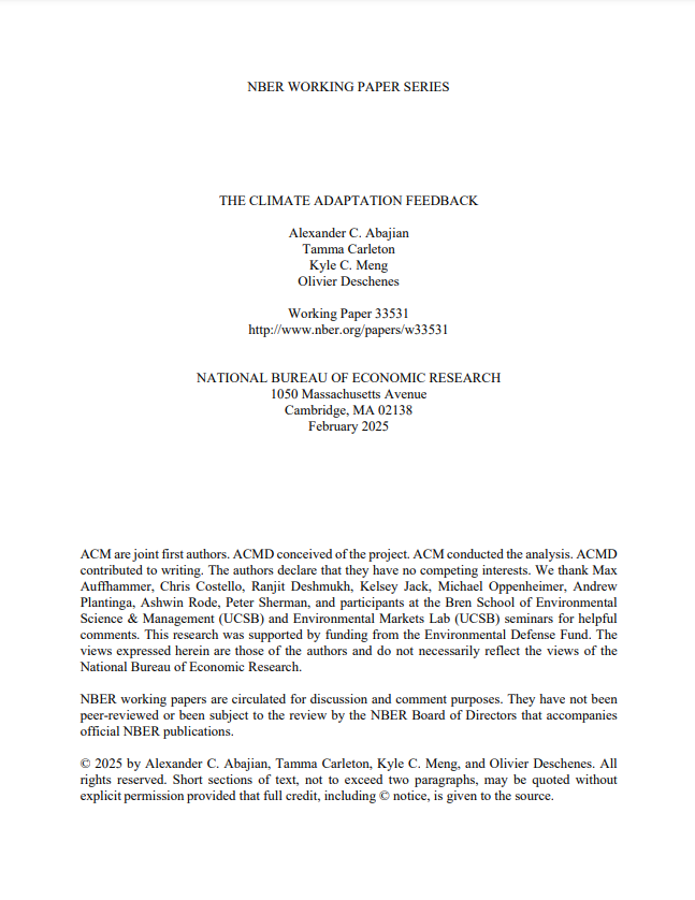
|
The Climate Adaptation Feedback
Many behavioral responses to climate change are carbon-intensive, raising concerns that adaptation may cause additional warming. The sign and magnitude of this feedback depend on how increased emissions from cooling balance against reduced emissions from heating across space and time. We present an empirical approach that forecasts the effect of future adaptive energy use on global average temperature over the 21st century.
2025.03
NBER
|
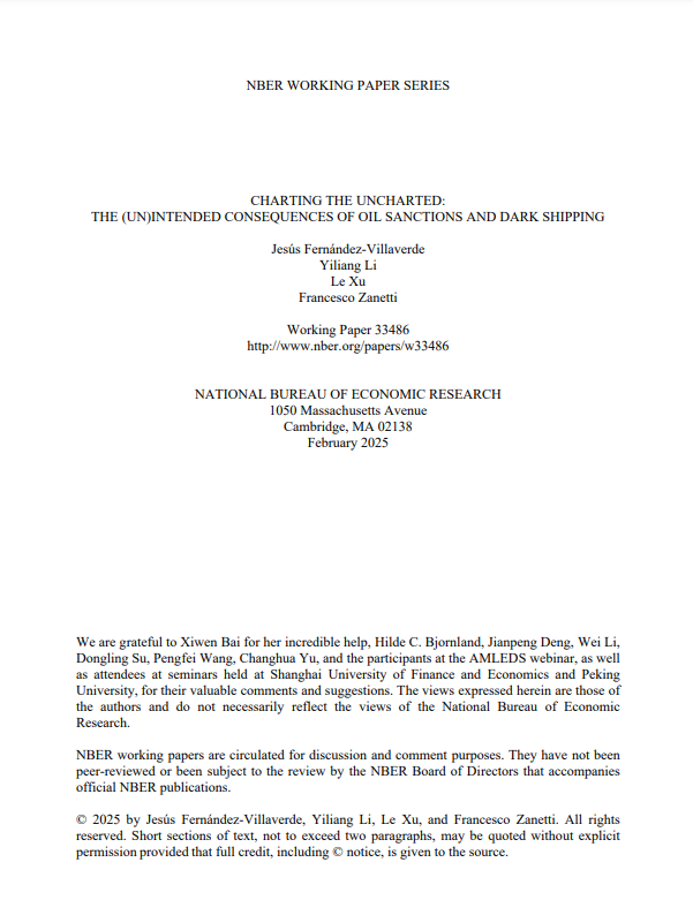
|
Charting the Uncharted: The (Un)Intended Consequences of Oil Sanctions and Dark Shipping
We examine the rise of dark shipping – oil tankers disabling AIS transceivers to evade detection – amid Western sanctions on Iran, Syria, North Korea, Venezuela, and Russia. Using a machine learning-based ship clustering model, we track dark-shipped crude oil trade flows worldwide and detect unauthorized ship-to-ship transfers. From 2017 to 2023, dark ships transported an estimated 7.8 million metric tons of crude oil monthly – 43% of global seaborne crude exports – with China absorbing 15%.
2025.03
NBER
|
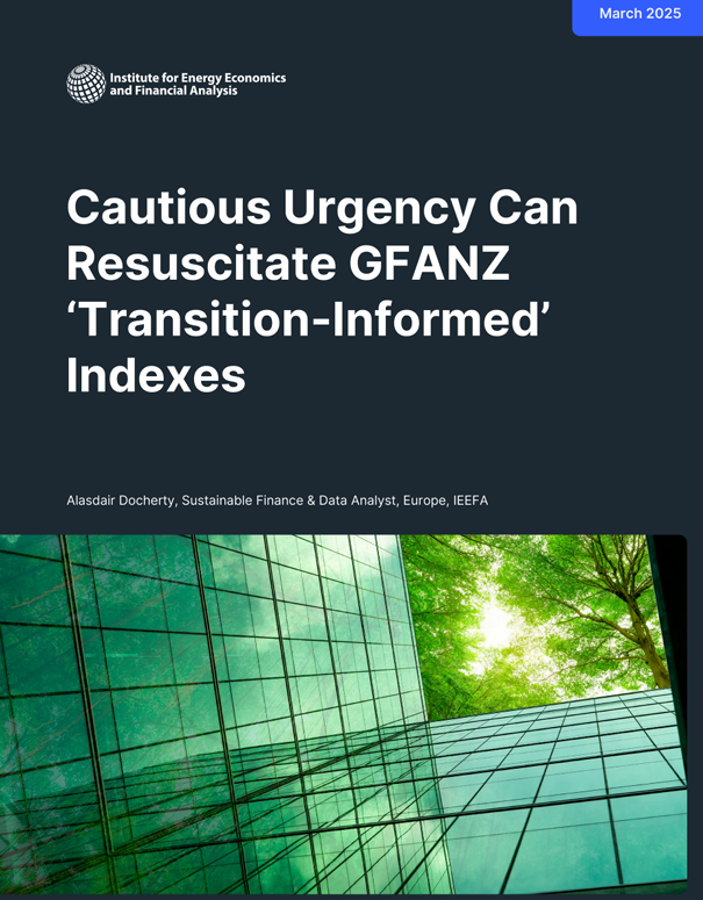
|
Cautious urgency can resuscitate GFANZ 'transition-informed' indexes
Despite growing diffidence towards collaborative action, financial institutions remain committed to their net-zero pledges. Combined with the fact that passive investing continues to dominate asset flows, the critical importance of benchmarks that can align assets with an orderly transition is both clear and growing by the year.
2025.03
IEEFA
|
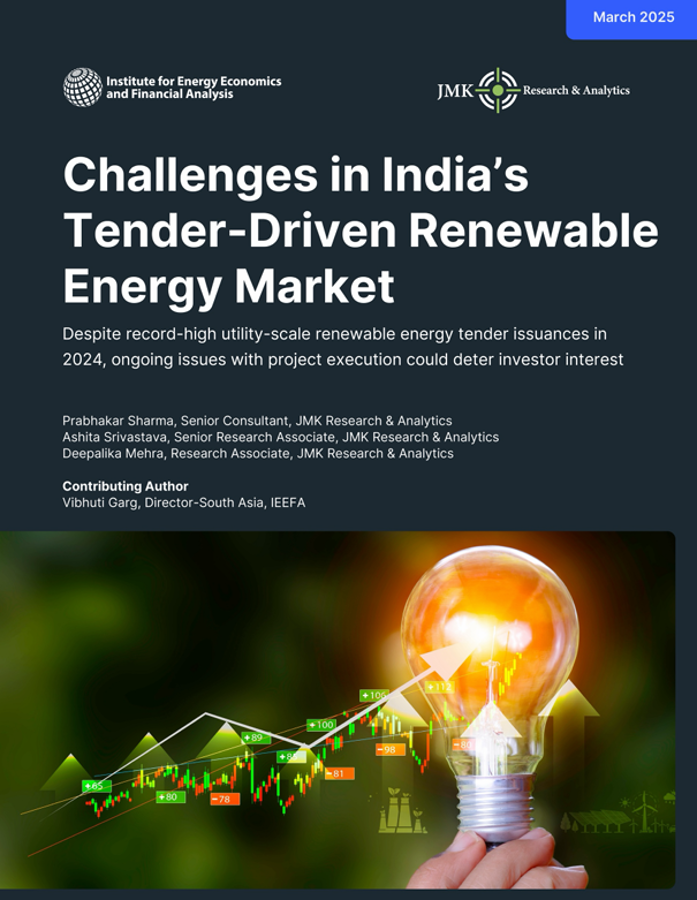
|
Challenges in India’s tender-driven renewable energy market
Powered by India’s annual bidding plan, a record 73 gigawatts (GW) of utility-scale renewable energy tenders were issued in 2024, with non-vanilla renewable technologies such as wind-solar hybrid and energy storage accounting for half of the issued capacity.
2025.03
IEEFA
|
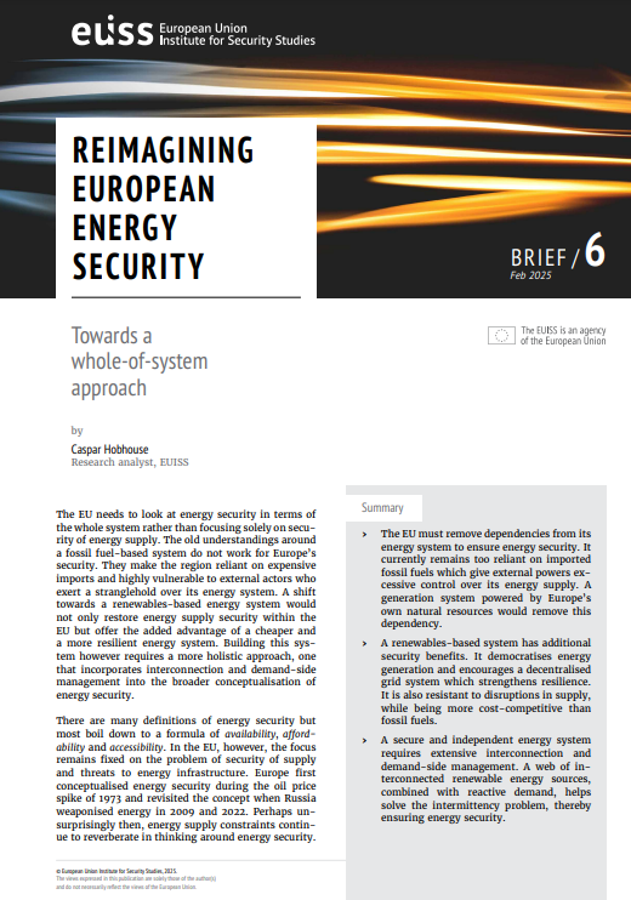
|
Reimagining European energy security: Towards a whole-of-system approach
The EU needs to look at energy security in terms of the whole system rather than focusing solely on security of energy supply. The old understandings around a fossil fuel-based system do not work for Europe’s security. They make the region reliant on expensive imports and highly vulnerable to external actors who exert a stranglehold over its energy system.
2025.02
EUISS
|
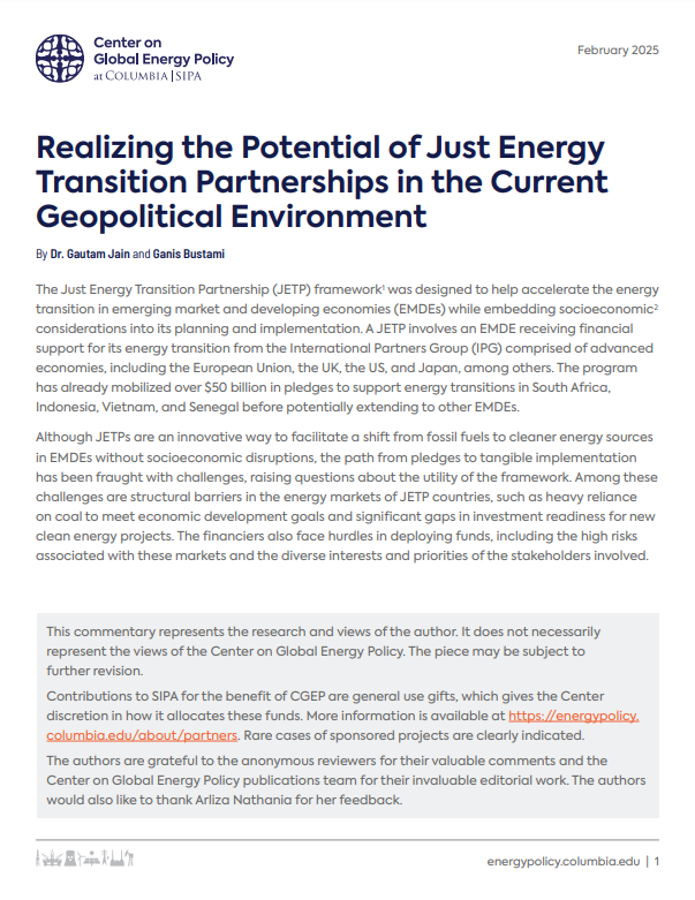
|
Realizing the Potential of Just Energy Transition Partnerships in the Current Geopolitical Environment
This commentary represents the research and views of the author. It does not necessarily represent the views of the Center on Global Energy Policy. The piece may be subject to further revision. Contributions to SIPA for the benefit of CGEP are general use gifts, which gives the Center discretion in how it allocates these funds. More information is available at Our Partners. Rare cases of sponsored projects are clearly indicated.
2025.03
CGEP
|
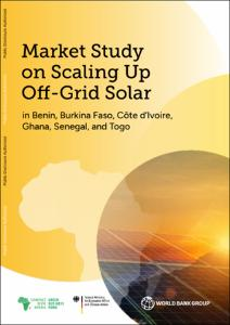
|
Market Study on Scaling Up Off-Grid Solar in Benin
The present report is based on data collected through an in-depth literature review on the six targeted countries as well as individual interviews with a total of 147 key off-grids solar (OGS) stakeholders across these countries, including (i) institutional players, comprising government and regulatory bodies, bilateral and multilateral donors, and nongovernmental organization (NGOs), (ii) solar companies, that is, importers, manufacturers, and distributors of solar equipment on cash and/or credit, for both domestic (lighting and entertainment) and productive purposes (for example, irrigation, cooling), (iii) financial institutions (FIs), comprising commercial banks, microfinance Institution
2025.03
World Bank
|
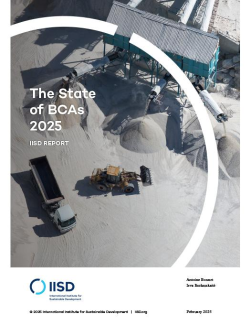
|
The State of BCAs 2025
As more countries strengthen their climate policies, concerns over carbon leakage—where emissions reductions in one country are offset by increases elsewhere—have grown. To address this, several countries are implementing border carbon adjustments (BCAs), with the European Union (EU) and the United Kingdom set to launch theirs by 2026 and 2027, respectively. This publication is the first of its kind taking stock of this trend.
2025.03
IISD
|
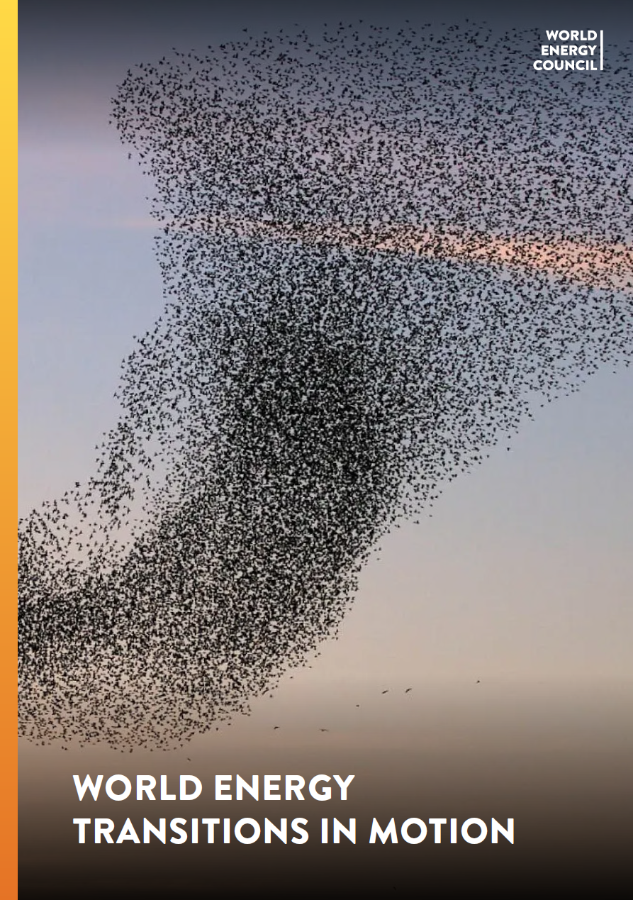
|
World Energy Issues Monitor 2025
Energy transitions around the globe are increasingly dynamic, emergent, and self-organising – much like the flocking of birds. Each bird reacts to its neighbours and surroundings, creating evolving formations that may look different from one moment to the next yet remain guided by the same basic rules. Energy transitions follow the same patterns, with a few unifying drivers – like climate concerns, technology advances, and social imperatives – shaping countless local variations, depending on political, economic, and cultural conditions.
2025.03
WEC
|
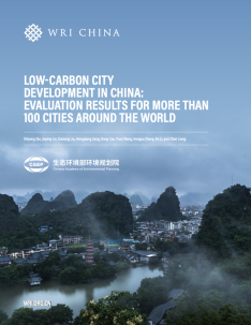
|
Low-Carbon City Development in China: Evaluation Results for More Than 100 Cities Around the World
This study constructs a low-carbon city evaluation system encompassing four key areas: low-carbon production, consumption, environment, and progress. Jointly developed by the World Resources Institute and the Chinese Academy of Environmental Planning, the study assesses 102 cities worldwide using 15 key indicators.
2025.03
WRI
|
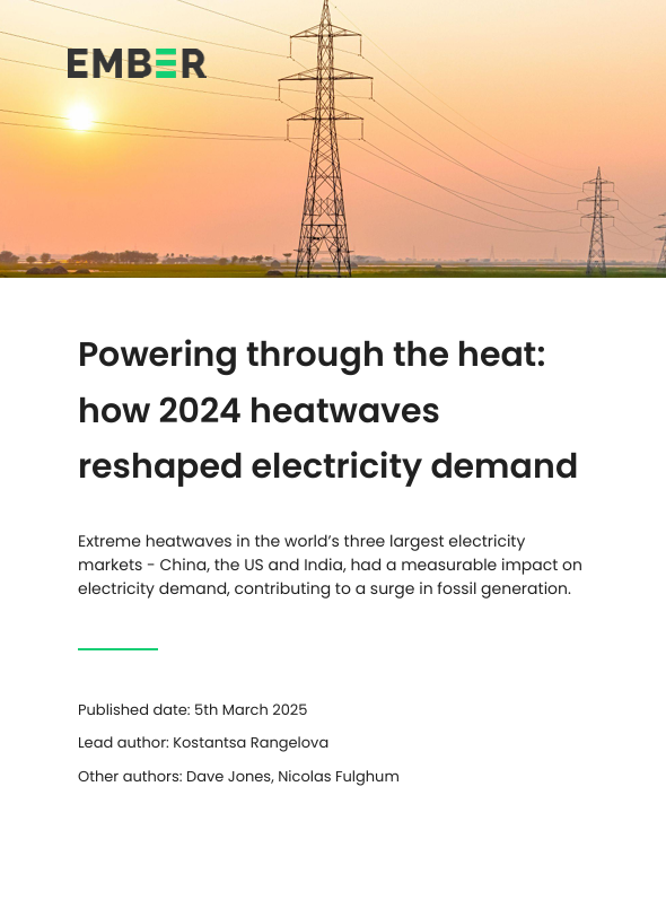
|
Powering through the heat: how 2024 heatwaves reshaped electricity demand
Extreme heatwaves in the world’s three largest electricity markets – China, the US and India, had a measurable impact on electricity demand, contributing to a surge in fossil generation.
2025.03
Ember
|
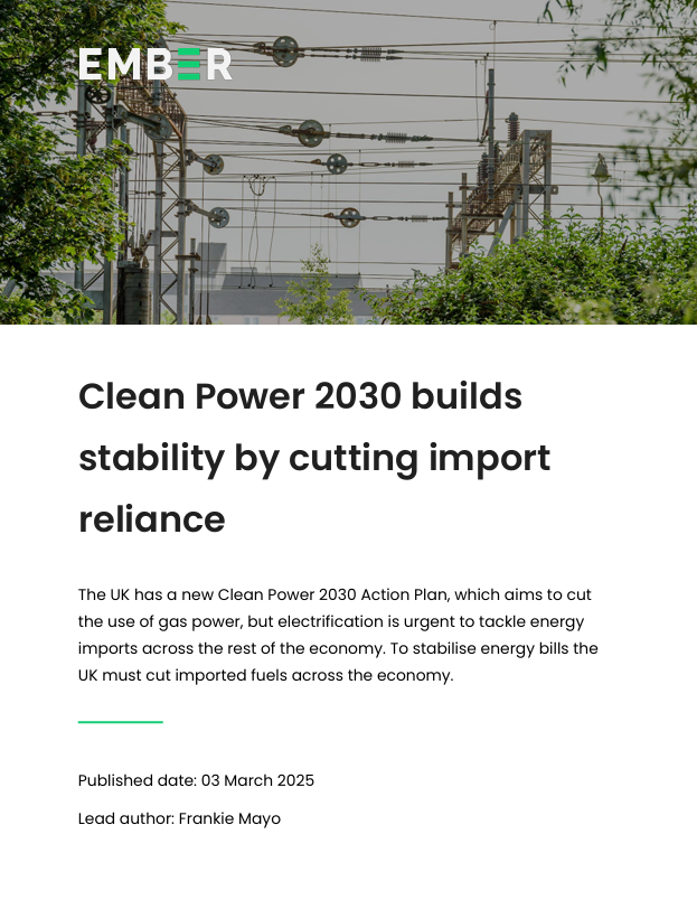
|
Clean Power 2030 builds stability by cutting import reliance
The UK has a new Clean Power 2030 Action Plan, which aims to cut the use of gas power, but electrification is urgent to tackle energy imports across the rest of the economy. To stabilise energy bills the UK must cut imported fuels across the economy
2025.03
Ember
|
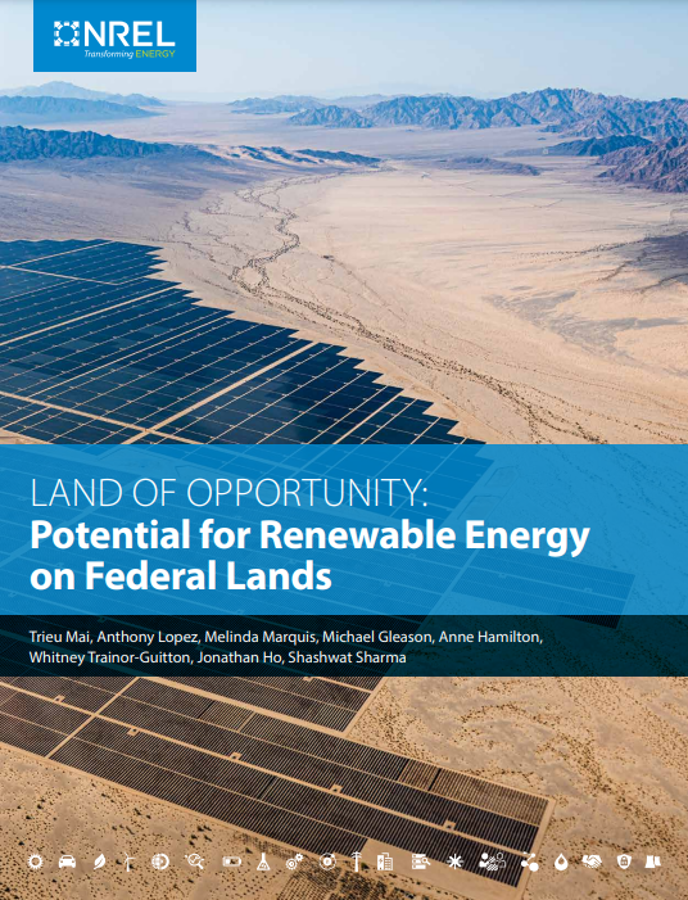
|
Land of Opportunity: Potential for Renewable Energy on Federal Lands
Renewable energy (RE) in the United States has historically been deployed primarily on private lands, but the growing interest in RE development, generally across the country and specifically on federal lands, raises questions about the potential for RE on public lands.
2025.01
NREL
|
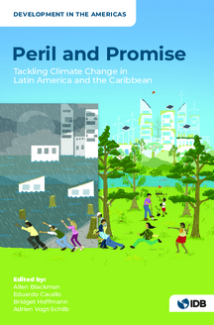
|
Peril and Promise : Tackling Climate Change in Latin America and the Caribbean
Climate change presents both a critical threat and a unique opportunity for progress in Latin America and the Caribbean. This book delves into this dual reality, showing that climate action is fundamentally development action, as it helps countries achieve crucial development goals in the short to medium term.
2025.03
IDB
|
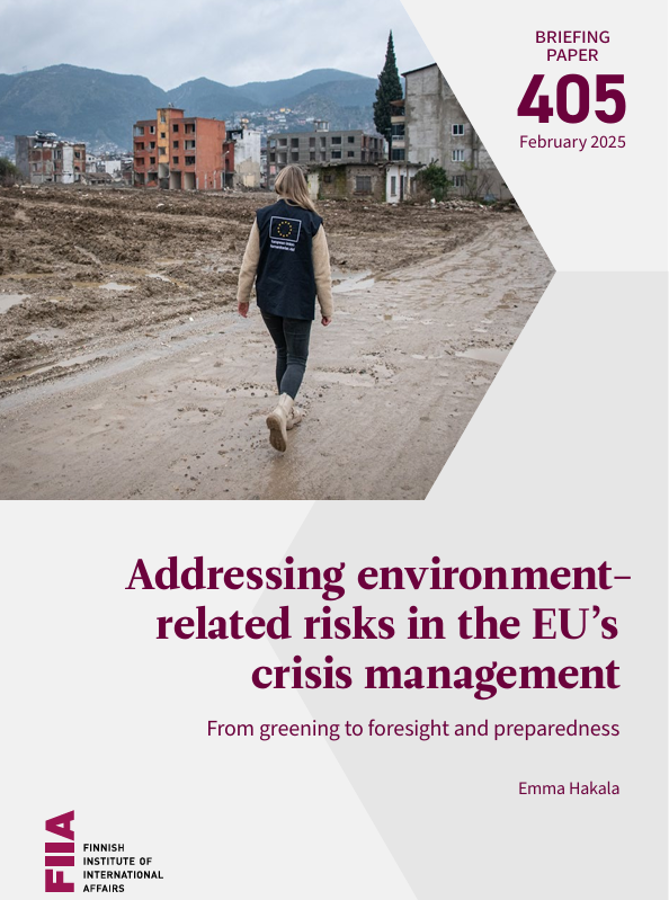
|
Addressing environment-related risks in the EU’s crisis management: From greening to foresight and preparedness
The EU and its crisis management efforts are increasingly challenged by environment related risks, such as extreme weather events and their implications for stability, migration and food security
2025.02
FIIA
|
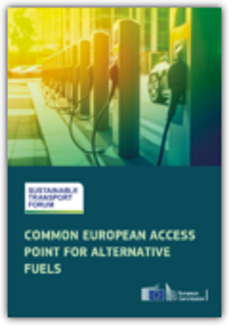
|
Common European access point for alternative fuels data
The deployment of alternative fuels infrastructure is critical to advancing sustainable transport across the EU. The common European access point (CEAP), mandated by the Alternative Fuels Infrastructure Regulation (AFIR) (Regulation (EU) 2023/1804), aims to facilitate access to data on recharging and refuelling infrastructure.
2025.03
European Commission
|
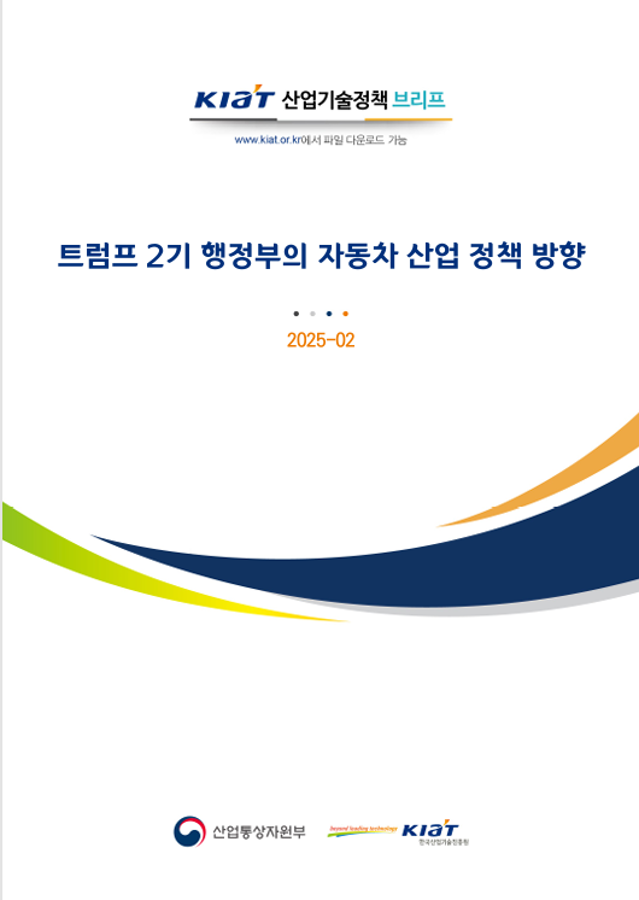
|
트럼프 2기 행정부의 자동차 산업 정책 방향
트럼프 2기 행정부의 자동차 산업 정책은 크게 ▲「인플레이션 감축법(IRA)」 ▲자동차 배출가스 규제 ▲관세 정책 ▲이민 정책 변경으로 요약할 수 있습니다. 「인플레이션 감축법(IRA)」의 전기차 세액공제가 축소·폐지될 경우 하이브리드차(HEV)의 중요성이 상대적으로 상승할 전망입니다.
2025.03
한국산업기술진흥원
|
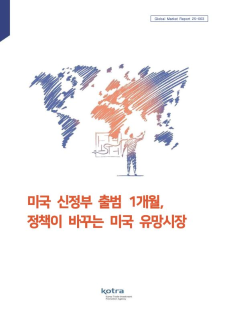
|
미국 신정부 출범 1개월, 정책이 바꾸는 미국 유망시장
美 트럼프 대통령은 취임(’25.1.20일) 이후 약 한 달간 경제·통상 관련 내용 포함 총 100개 이상 조치에 서명, 미국 중심 정책 추진하고 있으며 주로 경제 문제를 안보 이슈와 결합하여 국가별 또는 품목별 관세 조치 추진, 모든 국가 대상 상호 관세 추진을 예고하였다. 정책의 방향 및 규모에 따라 특정 산업·품목별로 미국 전체 시장 수요 크기, 국별 교역규모 등에 영향이 있을 것으로 전망된다.
2025.03
KOTRA
|
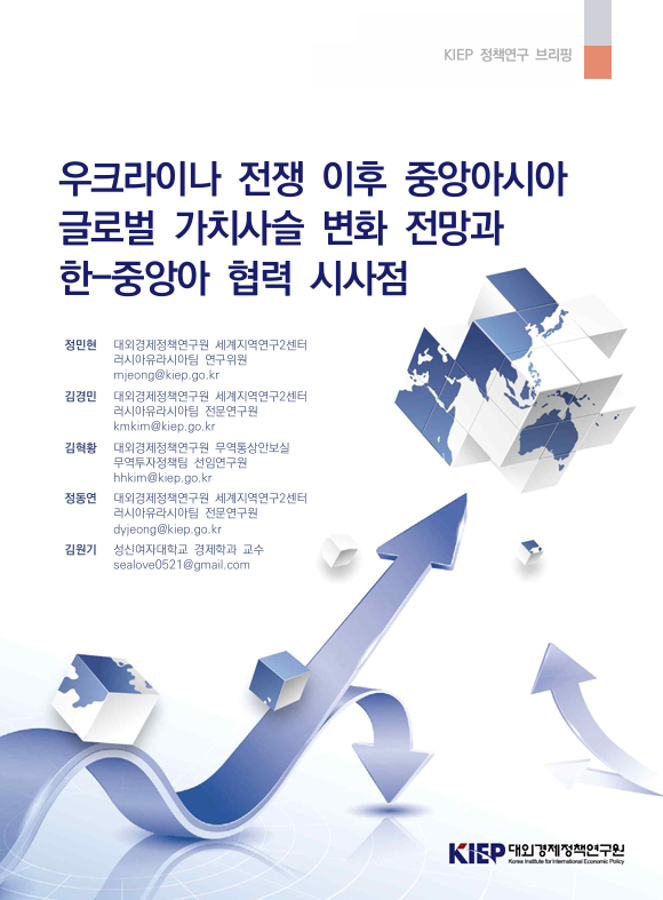
|
우크라이나 전쟁 이후 중앙아시아 글로벌 가치사슬 변화 전망과 한-중앙아 협력 시사점
러시아-우크라이나 전쟁 이후 중앙아시아 글로벌 가치사슬의 구조적 변동을 경제학적으로 엄밀하게 분석하고, 분석 결과를 토대로 한국과 중앙아시아의 새로운 경제협력 방향을 모색하고자 함.
2025.03
대외경제정책연구원
|
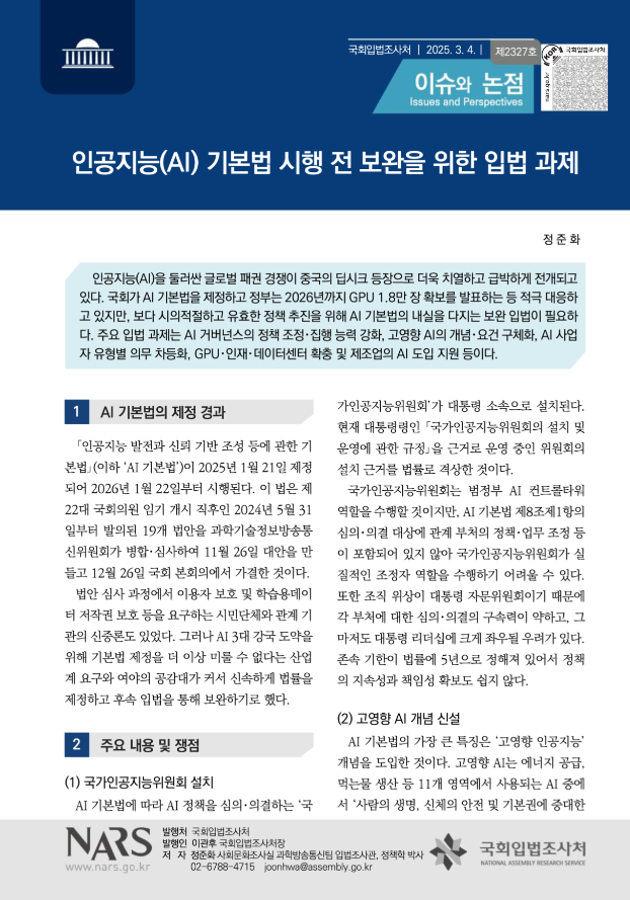
|
인공지능(AI) 기본법 시행 전 보완을 위한 입법 과제
인공지능(AI)을 둘러싼 글로벌 패권 경쟁이 중국의 딥시크 등장으로 더욱 치열하고 급박하게 전개되고 있다. 국회가 AI 기본법을 제정하고 정부는 2026년까지 GPU 1.8만 장 확보를 발표하는 등 적극 대응하고 있지만, 보다 시의적절하고 유효한 정책 추진을 위해 AI 기본법의 내실을 다지는 보완 입법이 필요하다.
2025.03
국회입법조사처
|
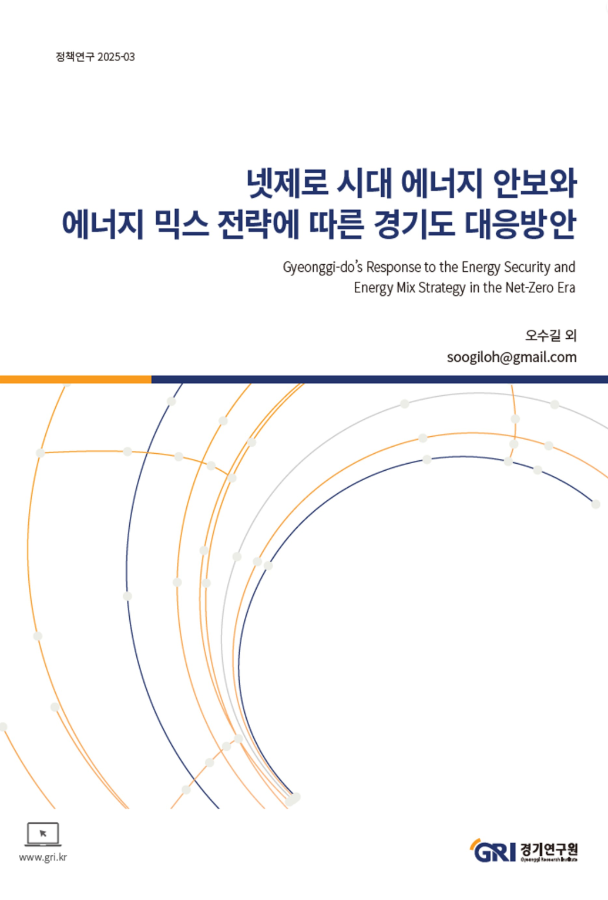
|
넷제로 시대 에너지 안보와 에너지 믹스 전략에 따른 경기도 대응방안
이 연구는 탄소중립과 에너지 안보 측면에서 에너지 믹스에 대한 방향 제시가 필요하다는 문제의식으로 탄소중립과 에너지 안보를 위한 에너지 믹스 시나리오 방향을 제시하고, 에너지 믹스 개선을 위한 주요 과제를 도출하는 것을 목적으로 한다.
넷제로 시대는 에너지 친환경성, 에너지 경제성과 더불어 에너지 안보가 에너지 전환을 가속하는 시대라 할 수 있는데, 에너지 믹스의 필요성이자 에너지 믹스의 3대 구성 요소이다. 에너지의 성질, 가용성, 비용, 공급 방식 측면에서 서로 다른 여러 가용 에너지원을 적절히 조합하여 에너지 수급을 원활하게 하는 깃이 에너지 믹스인 것이다.
글로벌 에너지 전환 동향을 보면, 에너지 전환은 단지 에너지 전환은 에너지원의 교체만이 아니라 생산, 공급, 소비 구조 전반의 혁신을 수반한다. 탄소중립 달성을 위한 핵심적인 기반을 마련하기 위해서는 효율성, 전기화, 재생에너지 등 세 기둥이 중요하다. 재생에너지는 화석연료 사용을 줄이는 핵심 전략인 전기화의 근간이 된다. 그리고 수소와 CCU/CCS는 이러한 세 기둥을 보완하는 중요한 수단이 된다.
2025.01
경기연구원
|
